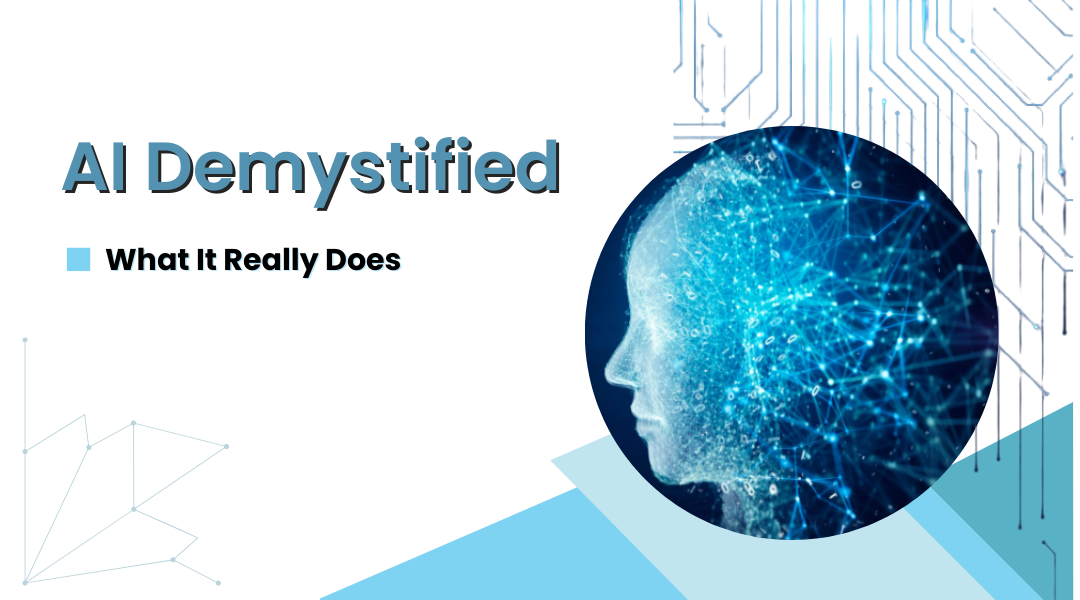Remember the first time you asked Siri for directions or let Netflix recommend your next binge-worthy show? That wasn’t magic—it was artificial intelligence at work. But despite its growing presence in our lives, AI remains shrouded in hype, confusion, and sci-fi fantasies. Let’s cut through the noise and talk about what AI actually is, where it shines, and why it still needs a human touch.
Breaking Down the Buzzwords
AI isn’t some all-knowing digital brain. It’s more like a really advanced tool that learns from examples. Here’s the real-world breakdown:
- AI (Artificial Intelligence): A broad term for systems that mimic human-like decision-making. Think of it like a chef who can tweak a recipe based on taste—except AI tweaks decisions based on data.
- Machine Learning (ML): AI’s learning engine. Instead of programming every rule (e.g., “If the sky is dark, it’s night”), you feed ML tons of weather data, and it figures out patterns on its own. It’s how Spotify learns your music taste—no manual rulebook required.
- Deep Learning: A powerhouse version of ML that crunches complex data (like images or speech) by mimicking how our brain’s neurons work. Ever wondered how Facebook recognizes your face in photos? That’s deep learning in action.
- Algorithms: Just step-by-step instructions, like a GPS calculating the fastest route. In AI, they’re the “how” behind the “what”—guiding systems to sort spam emails or predict traffic jams.
Key Takeaway: AI isn’t sentient. It’s a pattern-spotting tool that gets smarter with data, not intuition.
What AI Can (and Can’t) Do
AI isn’t a superhero—it’s a specialist. Traditional software follows rigid rules (“If X, do Y”). AI adapts. For example:
- Your email’s spam filter learns what “spammy” looks like over time, improving as it sees more examples.
- A self-driving car doesn’t just follow a map; it adjusts to real-time obstacles, like a sudden detour or a jaywalking pedestrian.
But here’s the catch: AI excels at narrow tasks, not broad reasoning. It can diagnose a tumor from an X-ray better than most doctors, but it can’t comfort a patient afterward.
Debunking the Biggest AI Myths
- “AI Can Solve Anything if You Throw Enough Data at It”
Nope. AI struggles with nuance. For example, it might flag a sarcastic email as “hostile” because it lacks human context. I once saw a retail AI overorder umbrellas after analyzing a rainy summer—it didn’t grasp that weather anomalies aren’t trends. - “AI Will Steal All Our Jobs”
History repeats itself. When ATMs arrived, people feared bank tellers would vanish. Instead, tellers shifted to advisory roles. AI will likely do the same—handling repetitive tasks (like data entry) while humans focus on strategy and creativity. - “AI Is Impartial and Error-Free”
AI mirrors our biases. Amazon scrapped an AI recruiting tool because it favored male candidates—the system learned from past hiring data skewed toward men. Without human oversight, AI can amplify flaws instead of fixing them.
How AI Actually Works: The Nuts and Bolts
Every AI system needs four things:
- Data: The fuel. Garbage in = garbage out. An AI trained only on sunny-weather data won’t recognize a hurricane.
- Algorithms: The recipe. They decide how the AI learns—like whether it prioritizes speed (e.g., fraud detection) or accuracy (e.g., medical diagnoses).
- Training: The trial-and-error phase. Just as a barista perfects espresso shots, AI refines its skills by testing predictions against real outcomes.
- User Interface: The bridge. Ever chatted with a customer service bot? A clunky interface can make even smart AI feel dumb.
The Bottom Line
AI isn’t here to replace us—it’s here to handle the tedious stuff so we can focus on what humans do best: creativity, judgment, and empathy. The future isn’t robots taking over; it’s doctors using AI to spot cancers earlier, or teachers personalizing lessons for each student.
The real power of AI? It’s not in the code—it’s in how we use it.
